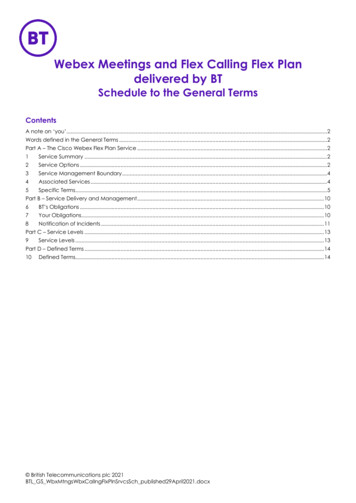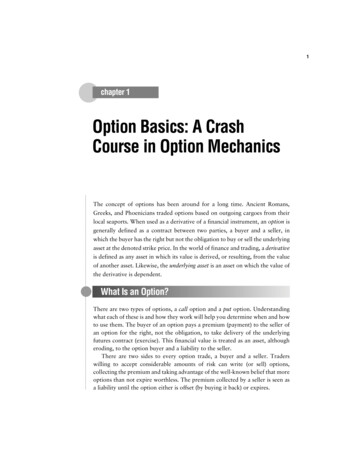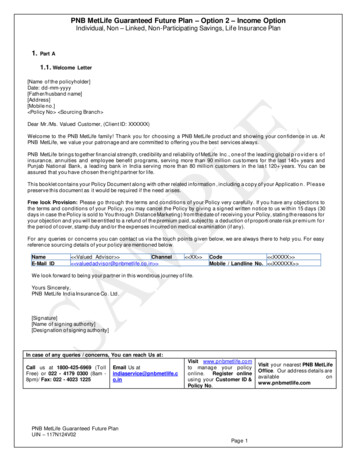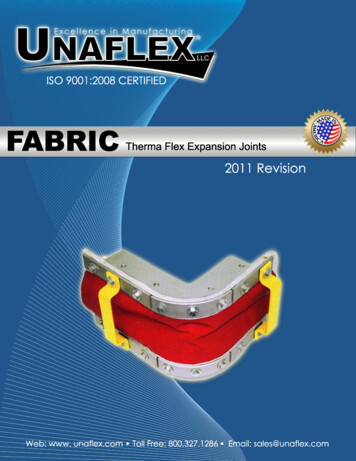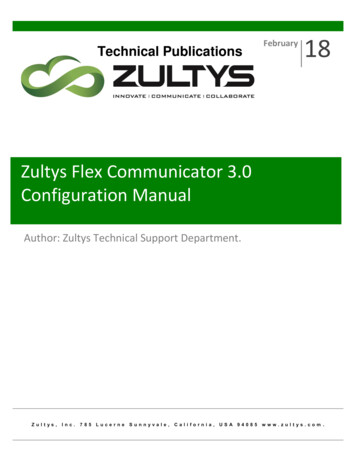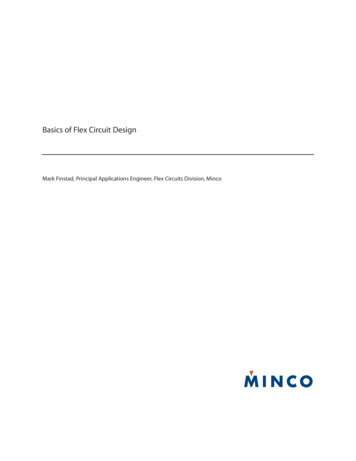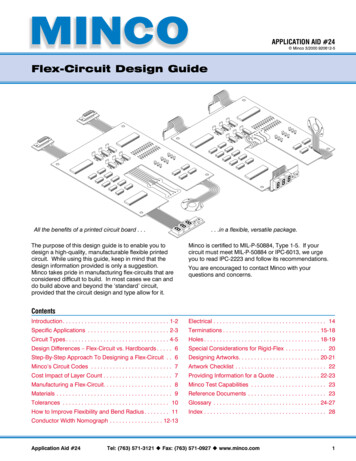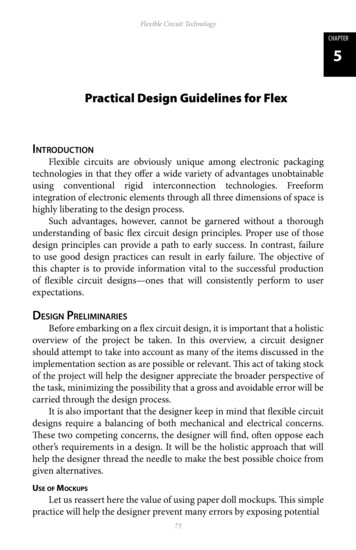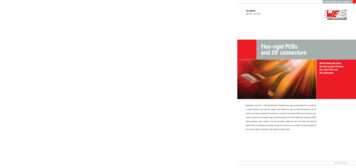
Transcription
2018 – 2019Annual Reportflex.wisconsin.edu
The UW Flexible Option launched in 2014 as a pioneer in online competency-basedhigher education. Five years later, it remains as one of the largest competency-basededucation enterprises at a public, statewide university system.The nine degrees and certificates that make up the UW Flexible Option are collaborationsbetween UW Extended Campus, UW-Milwaukee, UW-Parkside, and UW-Madison.These programs are innovative avenues for adult learners to leverage their knowledgeand experience to earn accredited University of Wisconsin degrees or certificates—allon their own schedule.Well over 500 students have already graduated from a UW Flexible Option programsince its inception. These are students who regularly tell us they would not have beenable to achieve their degree or certificate if it weren’t for this program.This is the annual report for the 2018–2019 fiscal year. Throughout this report, you willfind that the focus is on the stories of our students. These success stories are whatpower the UW Flexible Option, and the ones presented here are just a fraction of thenearly 1,000 unique students who enrolled in the UW Flexible Option throughout the2018–2019 fiscal year.These students are predominantly adult learners—the median age is 34—and the vastmajority are balancing work, school, and family commitments. The UW Flexible Optionis designed to allow these students to fit school into their life, rather than having to fittheir life around school, making it a point of access for university credentials that most ofthese students would not have had otherwise.I am proud of the accomplishments of this program and its students in the past year. TheUW Flexible Option was a bold rethinking of higher education with its launch five yearsago. Now, as it prepares to enter its next five years, I eagerly look forward to the excitingways this program will continue to grow, serve its students, and be a national leader incompetency-based education excellence.Aaron Brower, Ph.D.Executive Director of UW Extended Campus, &Senior Associate Vice President for Academic Affairs at UW System Administration1
Here’s what makes UW Flexible Option programsunique and advantageous for you:»»Start when you want, at the beginning of any month. You enroll for three-month subscription periods—the periods of time during which you’re able to access learning materials, complete assessments,and receive academic support. Your progress is not limited by a traditional semester or term-basedschedule, and you can take breaks in between subscription periods if and when you need to. If you havea vacation planned or know that a particular month is a busy time at work, you’ll be able to take a breakand jump right back into your program the next month.»»Tap into existing knowledge to save time and money. You may draw upon knowledge you’ve previouslygained through work experience or coursework to complete assessments and progress toward yourdegree or certificate more quickly.»»Enjoy flat-rate tuition. Rather than being charged per credit, students pay a flat rate for one of twosubscription period options. If you’re highly motivated with lots of experience, consider an All-You-CanLearn subscription to master as much material as you can in three months. Want to study at a slowerpace? Try a Single Competency Set subscription. Please note, the Single Competency Set option is notavailable for all programs. Many of our programs are eligible to distribute Federal Financial Aid, andmany students are able to use tuition reimbursement from their employers.»»Advance at your own pace. Progress toward your degree or certificate is based on assessments ofkey competencies determined by UW System faculty, not seat time in a classroom. Take assessmentswhenever you are ready during your three-month subscription period. Pass one and move on to thenext. No more waiting for professors to move through a syllabus schedule or sitting through lectures onmaterial you already know.»»Receive personalized support. A dedicated Academic Success Coach will work with you to create yourlearning plan and a timeline tailored to fit your goals, knowledge, and past experience.»»Learn skills employers value. As each program is developed, distinguished UW System faculty drawupon the latest business and industry standards to identify the essential competencies required forgraduation or program completion. This ensures that UW Flexible Option students are equipped withthe knowledge and skills employers need.»»Earn a genuine University of Wisconsin credential. The UW System is one of the largest, and mostwidely respected, public higher education institutions in the country. UW Flexible Option programs arecreated by the same faculty using the same rigorous standards as traditional UW programs. That meansyou’ll earn the same high-quality, accredited degree or certificate as students who attend class oncampus. These are degrees and certificates that employers will recognize and respect.2
Bachelor of Science inNursing (RN to BSN)The UW Flexible Option Bachelor of Science in Nursing(BSN) program is a convenient option for RN licensednurses to earn their bachelor’s degree. Offered through theUW-Milwaukee College of Nursing—a nursing college in thetop 15% of the nation—this program helps nurses build on theirwork experience and their associates degree to more quicklyearn their BSN. Students master a range of competencies thatare in demand from hospitals and clinics, such as evidencebased practice, community health nursing, and chroniccare management.This year, the UW Flexible Option BSN program hit a majormilestone: it now has over 100 graduates. With a strong retentionrate of 84% and nearly 400 students this year, this program hasa noticeable impact on the nursing industry in Wisconsin andis helping students meet workforce needs. A new competencyset, Palliative Care, was also developed this past year as part ofcontinual revision efforts to keep the program up to date withindustry needs. While this program has historically only beenable to admit students from Wisconsin and, more recently,Illinois, the BSN program can now begin admitting studentsfrom Indiana, Iowa, and nearly any state beyond.389389Students Enrolledin FY1984%84%Retention113113Graduates
Assistant Head Nurse Advances Her Career and ICU ThroughUW Flexible OptionWith over 15 years of experience as a staff nurse, along with recently“The program gave me a basis for what elements really make anearning her Bachelor of Science in Nursing (BSN), one thing mightimpact on patient outcomes, because I was directly seeing themsurprise you about Tiffany Breezee — she dropped out of high school.in my work,” Tiffany said. “As an assistant head nurse, I knew Iwanted to focus my attention on developing a unit that spoke to“When you’re younger and you think about what you’rethe practice and the work that our nurses do every single day.”going to do with your life, you don’t really expect to knowhow your future is going to pan out,” Tiffany said.For her capstone project, Tiffany drew on everything she learned in theonline BSN program, and yielded positive results for the ICU at EssentiaIn her eyes, Tiffany’s career journey is a convoluted tale. Frustratedwith 70-hour work weeks at three different jobs, Tiffany was dissatisfiedwith her future outlook and knew she needed to change her path.Health. Her team was dealing with a significant level of clostridiumdifficile (C.diff) bacteria infections among patients who were experiencingdiarrhea, abdominal cramping, dehydration, and in more serious cases,At 18, Tiffany completed her high school equivalency diploma. Then,inflammation of the colon. Tiffany saw her capstone project as anat 21 she pursued an associate’s degree in nursing at Wisconsinopportunity to contribute to her current patients’ health and decided toIndianhead Technical College (WITC). Having always been drawnfocus her capstone on decreasing the infection prevalence in her unit.to science and looking for a career that would both challenge andmotivate her, Tiffany saw nursing as a new and proactive role in whichTiffany and the nursing staff’s main goal was focused on bedside nursingto apply herself. Admittedly, Tiffany knew very little about what sheinterventions that would lead to a significant risk reduction for their high-riskwas getting into — no one in her family had obtained a medical sciencepatient population, such as proper patient placement, preemptive isolationprofession degree before — but she was determined to at least try.criteria, infection prevention education on the correct donning and doffingof personal protective equipment, standardized stocking processes toThree years later, Tiffany graduated from WITC with an associate’sdegree and passed the NCLEX exam. As a new registered nurse, Tiffanyreduce cross contamination, effective hand washing, and more.felt like she had made it. Next, she worked her way from registeredTiffany presented her research-based project findings to thenurse to assistant head nurse of the surgical intensive care unit (ICU)management teams at Essentia Health’s ICU. Managers implementedat Essentia Health in Duluth, MN. There, she influences decisionsmany of Tiffany’s recommendations.regarding unit improvements, speaks to the work of the nursing staff,“At the end of the day, we wound up with an 86 percent reductionand advocates for advancements in bedside care. However, oncein our C.diff infection rate, which is well beyond what’s expectedagain, Tiffany knew she wanted to do more, and the next logical stepin literature and other research,” Tiffany said. “The majority of thewas to obtain her BSN and reach her full potential as a nurse.interventions that led to this success were nursing driven, becauseLisa Mihlbauer, a clinical associate professor and the director of RN-we were able to find the knowledge gaps that our nursing staffto-BSN completion programs at UW-Milwaukee College of Nursinghad. The project was a great indication of what you can accomplishhas taught many students during more than 35 years at the university.when you apply the core concepts of your education.”When Tiffany was in her genetics and capstone competency sets,News of Tiffany and the nursing staff’s C.diff infection reduction successhowever, her work instantly stood out to Professor Mihlbauer.circulated, and they were recognized by Essentia Health’s CEO. Their“I had never seen assessments so well done,” Professor Mihlbauerwork was also forwarded systemwide to improve other departments.recalled. “I was shocked at her level of proficiency, so much so that whenI first read her submission I reached out to Tiffany’s academic successcoach right away and asked if she had a previous baccalaureate degree,because she appeared to be almost an expert writer on the subject.”“If what we found has greatly impacted the care of thenurses we have — it’s exciting to think about how this positiveoutcome can help even larger populations,” Tiffany said.Tiffany attributes her success in the UW Flexible Option RN to BSNonline degree program to her work experience as an ICU nurse.20142014Programlaunch date891189% /11%Ratio of femaleto male students3434Median age4
Bachelor of Science inBiomedical Sciences:Diagnostic ImagingBachelor of Science inBiomedical Sciences:Health SciencesThe UW Flexible Option Bachelor of Science in BiomedicalSciences: Diagnostic Imaging, offered by UW-MilwaukeeCollege of Health Sciences, is a degree completion program formedical imaging professionals. Building off of an active registryin the field, this degree prepares sonographers, radiologists,MRI technicians, and other imaging professionals to take theircareer to the next level. In the curriculum, students study arange of skills—such as healthcare leadership, client diversity,and human pathophysiology—which ensures students arestaying on top of the in-demand skills that employers arelooking for out of its future leaders. The UW Flexible OptionDiagnostic Imaging program had over 100 unique studentsenrolled throughout this past year.The UW Flexible Option partners with the UW-MilwaukeeCollege of Health Sciences on a second degree completionprogram, a Bachelor of Science in Biomedical Sciences: HealthSciences. Students with an associates degree in any field areawarded a minimum of 60 credits toward this degree. Thisprogram is ideal for students who are looking to advance theircareer in a diverse range of opportunities including work inboth clinical and non-clinical settings such as hospitals, generalcare facilities, public and private agencies, nonprofits, and otherhealth-related organizations. This program can also providethe foundation required for entering into advanced degreeprograms such as physical or occupational therapy, physician’sassistant, and more. The Health Sciences degree is one of thenewest UW Flexible Option degrees, having launched in 2018,and is currently pursuing approval to offer federal financial aid.118118Students Enrolledin FY1964%64%Retention3535Graduates
Bachelor’s Degree in Diagnostic Imaging Opens Doors forCollege InstructorKrysti is applying the knowledge gained in her degree program to both ofKrysti Reece is passionate about the medical imaging field.her positions, transforming what she’s learning into new insights on improved“There’s always a lot of change going on, advances in technology, and apatient care.greater role for me to play in my patient’s diagnosis,” she says. “There’s“Even though I’m with my patients for only a short time, I’m making greatnever a dull moment. I love what I do.”strides in their diagnosis. Through my coursework, I’m learning howKrysti has two jobs as a working sonographer and diagnostic medicalinterrelated communication is to healthcare and how to improve mysonography instructor at a local community college. With all her training andcommunication skills. I’m also being introduced to broader healthcarenearly a decade of work experience, Krysti is still missing the one credentialconcepts such as ethical issues in patient care and how to think moreshe needs to achieve her career goals.critically about every patient and provider interaction.”“I’m interested in advancing my role at the community college. But youKrysti shares her enthusiasm for learning with her students at Triton College,definitely can’t do that in higher education without at least awhere she is a full-time instructor and clinical coordinator in the Diagnosticbachelor’s degree.”Medical Sonography department.That’s why she’s completing her Bachelor of Science in Biomedical Sciences:“Medical imaging is an in-demand field,” says Krysti. “Most of my associateDiagnostic Imaging through the UW Flexible Option. Students with an activedegree students have jobs lined up or are actively interviewing priorregistry are awarded credits toward their bachelor’s degree. This includesto graduation.”the following active registries:»»What’s next for Krysti? After graduating in 2018, she hopes to further herARDMS (American Registry for Diagnosticcareer in higher education, and continue on for her master’s degree. SheMedical Sonography)foresees enormous advances in the imaging field, with technology continuingARMRIT (American Registry of Magnetic Resonanceto evolve and the opportunity for technologists to have an unprecedentedImaging Technologists)impact on healthcare.»»ARRT (American Registry of Radiologic Technologists)“The future of diagnostic imaging is wide open. For ultrasound specifically,»»CCI (Cardiovascular Credentialing International) registry»»the new imaging techniques and the number of specializations is constantlygrowing. Every day, there is more to learn,” Krysti shares.“With my switch to a more active role in education and the encouragementHer advice for prospective students?from the college to complete my degree, I knew now was the best time toget started. My colleagues and my family—I have a husband and two kids—“I recommend UW Flexible Option for anyone who is pursuing aare all very supportive and encouraging,” says Krysti.management or educator role. It’s affordable, provides a good value, and ittruly is flexible.”For Krysti, returning to school was a matter of finding the right fit.“With two jobs and two kids, plus the occasional 70-hour work week, gettingto campus and sitting in a classroom just wasn’t going to happen.”UW Flexible Option puts adult students in control of their schedules.Students enroll in three-month subscription periods and complete the workat their own pace.“The best part about UW Flexible Option is the ability to do my homeworkon my own schedule. I budget my time however I need, plan around my workschedule, and I can take a break if necessary.”201420182014 Diagnostic Imaging2018 Health SciencesProgramlaunch dates811981% /19%Ratio of femaleto male students32353532MedianageMedian age6
Bachelor of Science inInformation Science &TechnologyThe UW Flexible Option Bachelor of Science in InformationScience & Technology (IST) program, offered by UWMilwaukee’s School of Information Studies, prepares studentsto be IT leaders in this increasingly digital economy. Thiscurriculum emphasizes core IT skills like front-end web design,HCI and database management, information architecture,human-computer interaction, information organization, storageand retrieval, and applications of the Internet. This program isspecifically designed for industry professionals with at leastone year of IT experience, making it the competency-basedenvironment ideal for these professionals to leverage theirexperience to more quickly progress toward their degree.Throughout this year, over 200 UW Flexible Option studentsenrolled in the IST program, and the program is nearing 100graduates since its launch. A unique opportunity within thisdegree program is that students have the option to use someof their elective credits to earn the Business & TechnicalCommunications certificate, also through the UW FlexibleOption. This offers an additional competitive advantageto students in the workplace because effective technicalcommunications is a high-demand skillset. Overall, the UWFlexible Option Information Science & Technology is the onlyIT program of its type in the UW System, and it continues tobe a convenient option for adult learners to earn their degree.210210Students Enrolledin FY1978%78%Retention9898Graduates
Network Engineer Earns IT Degree by Completing 51 Credits in9 MonthsTyler Coady earned his Information Science and Technology (IST) bachelor’s“None of this would have been possible without the help of my Academicdegree in only nine months. What made the UW Flexible Option so right forSuccess Coach, Danielle.”him? Here are ways the unique format of UW Flexible Option fit Tyler’s life.For adult students, returning to college can be intimidating. Your AcademicFor many adult students who are balancing work, family, hobbies, or otherSuccess Coach is there to help motivate you, help you plan your schedule,priorities, a traditional, face-to-face college experience isn’t an option. Withoffer study tips, navigate the learning system, and more. They’ll alsoUW Flexible Option, the online format meant no commuting to campus andperiodically check in just to see how you’re doing.no sitting in class.“Danielle was excellent at helping me plan my degree. She was alwaysTyler said, “At first, I wasn’t sure how I would be able to fit a degree into myavailable when I sent her emails and was incredibly helpful in dealing withlife. My wife and I moved every year. But then I did some research and foundany issues that came my way.”UW Flexible Option and knew I could finally earn my degree online.”Tyler graduated from the University of Wisconsin-Milwaukee School ofThe UW Flexible Option IST degree is offered through the University ofInformation Studies with a Bachelor of Science in Information Science andWisconsin-Milwaukee School of Information Studies.
The UW Flexible Option Bachelor of Science in Nursing (BSN) program is a convenient option for RN licensed . nurses to earn their bachelor’s degree. Offered through the UW-Milwaukee College of Nursing—a nursing college in the top 15% of the nation—this program helps nurses build on their
